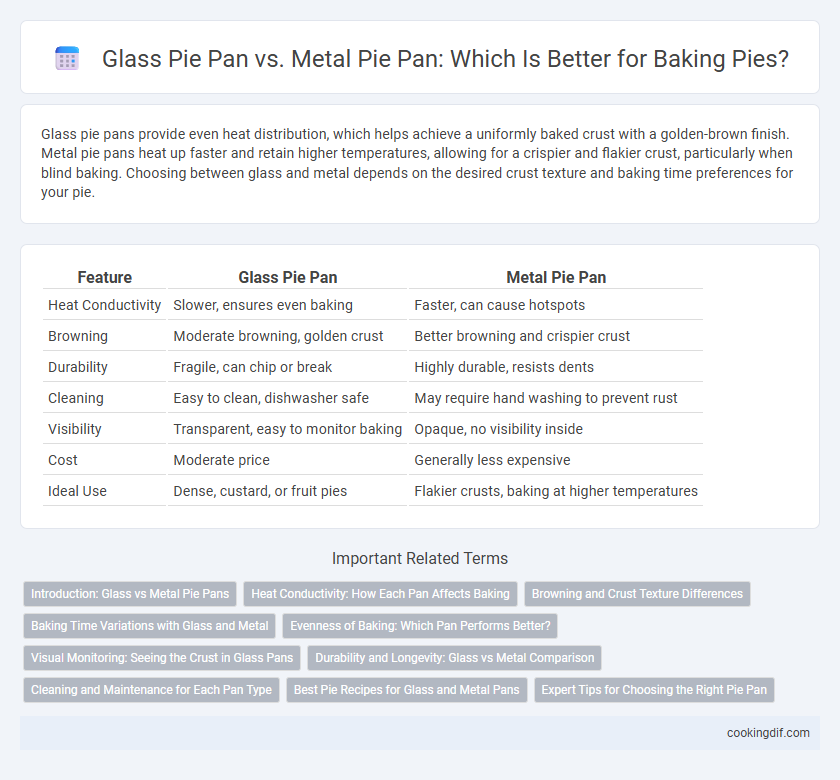Glass pie pans provide even heat distribution, which helps achieve a uniformly baked crust with a golden-brown finish. Metal pie pans heat up faster and retain higher temperatures, allowing for a crispier and flakier crust, particularly when blind baking. Choosing between glass and metal depends on the desired crust texture and baking time preferences for your pie.
Table of Comparison
| Feature | Glass Pie Pan | Metal Pie Pan |
|---|---|---|
| Heat Conductivity | Slower, ensures even baking | Faster, can cause hotspots |
| Browning | Moderate browning, golden crust | Better browning and crispier crust |
| Durability | Fragile, can chip or break | Highly durable, resists dents |
| Cleaning | Easy to clean, dishwasher safe | May require hand washing to prevent rust |
| Visibility | Transparent, easy to monitor baking | Opaque, no visibility inside |
| Cost | Moderate price | Generally less expensive |
| Ideal Use | Dense, custard, or fruit pies | Flakier crusts, baking at higher temperatures |
Introduction: Glass vs Metal Pie Pans
Glass pie pans provide even heating and allow bakers to monitor crust browning for precise baking, making them ideal for fruit pies requiring consistent heat. Metal pie pans heat up and cool down quickly, promoting a flakier, crisper crust suitable for delicate pastries and custard pies. Choosing between glass and metal depends on pie type and desired crust texture, with glass offering visual control and metal delivering superior heat conduction.
Heat Conductivity: How Each Pan Affects Baking
Glass pie pans have lower heat conductivity than metal pans, causing them to heat more slowly and provide more even baking, which helps prevent over-browning of crust edges. Metal pie pans, particularly aluminum, conduct heat quickly and efficiently, leading to faster cooking times and crispier, browner crusts. Choosing between glass and metal pans affects heat distribution and baking results, with glass favored for gentle, even cooking and metal preferred for achieving a golden, crunchy crust.
Browning and Crust Texture Differences
Glass pie pans distribute heat more evenly and retain heat longer, resulting in a more uniform browning and a slightly softer crust texture. Metal pie pans heat up quickly and promote a crisper, flakier crust with more distinct browning along the edges. Choosing between glass and metal depends on the desired crust texture and browning intensity for a perfect pie.
Baking Time Variations with Glass and Metal
Glass pie pans typically require longer baking times than metal pans due to their slower heat conduction, resulting in more even cooking but extended bake duration. Metal pie pans heat up quickly, promoting faster browning and shorter baking times, which is ideal for achieving a crispier crust. Adjusting baking times by approximately 5-10 minutes when switching between glass and metal pans ensures optimal pie texture and doneness.
Evenness of Baking: Which Pan Performs Better?
Metal pie pans conduct heat more efficiently than glass pans, resulting in a crisper, more evenly baked crust. Glass pie pans heat gradually and retain heat longer, which can cause the pie crust to brown unevenly or bake slower in certain areas. For consistent evenness of baking, metal pans are generally preferred by professional bakers seeking optimal crust texture and doneness.
Visual Monitoring: Seeing the Crust in Glass Pans
Glass pie pans offer superior visual monitoring during baking, allowing you to see the crust's color and texture as it develops. This transparency helps prevent overbaking or underbaking by providing immediate visual feedback. Metal pie pans, by contrast, lack this clarity, making it harder to judge the crust's doneness without opening the oven.
Durability and Longevity: Glass vs Metal Comparison
Glass pie pans offer excellent durability with resistance to warping and staining, maintaining their clarity and structural integrity over time. Metal pie pans, often made from aluminum or stainless steel, provide superior heat conductivity but may be prone to dents and corrosion, affecting longevity. Choosing between glass and metal depends on prioritizing long-term durability versus efficient heat transfer for baking.
Cleaning and Maintenance for Each Pan Type
Glass pie pans are non-porous and resist staining, making them easier to clean and maintain after baking, often requiring just warm soapy water to restore their clarity. Metal pie pans can develop baked-on residue and may require more intensive scrubbing or soaking, especially if they are uncoated or aluminum, which can also be prone to discoloration and corrosion over time. Both types benefit from avoiding abrasive cleaners, but glass pans generally offer a lower-maintenance option for preserving appearance and hygiene.
Best Pie Recipes for Glass and Metal Pans
Glass pie pans provide even heat distribution, resulting in a consistent crust browning, which is ideal for delicate pies like custard and fruit pies that require gentle baking. Metal pie pans, especially those made from aluminum or steel, conduct heat more rapidly, producing a crispier crust perfect for savory pies or recipes needing a firm base, such as quiches and pot pies. For the best pie recipes, use glass pans for sweet, moist fillings and metal pans for pies where a golden, flaky crust is essential.
Expert Tips for Choosing the Right Pie Pan
Glass pie pans offer even heat distribution, which helps achieve a beautifully browned crust, making them ideal for custard and fruit pies. Metal pie pans provide superior heat conductivity and faster baking times, perfect for achieving a crisp, flaky crust in pies requiring high temperatures. Experts recommend choosing glass pans for delicate, slow-baked pies and metal pans for recipes needing quick, high-heat exposure to ensure optimal pie texture and flavor.
Glass pie pan vs metal pie pan for baking pies Infographic

 cookingdif.com
cookingdif.com